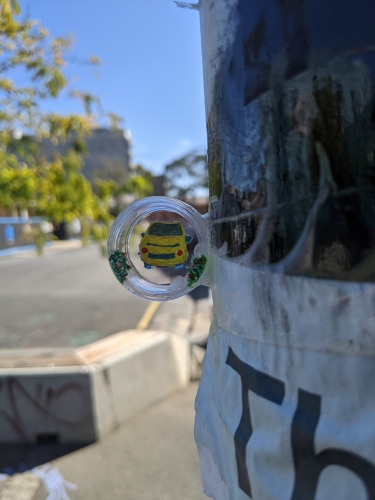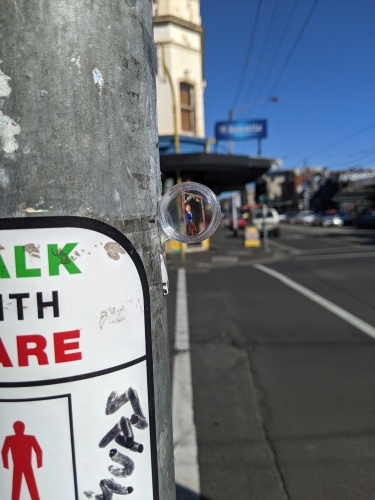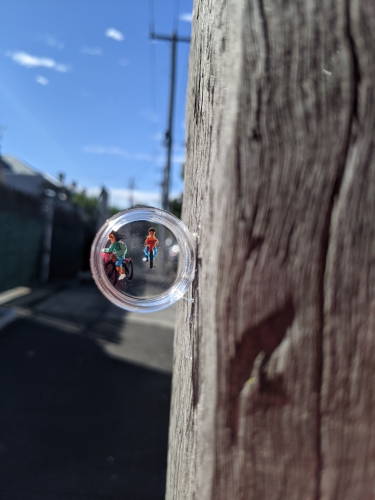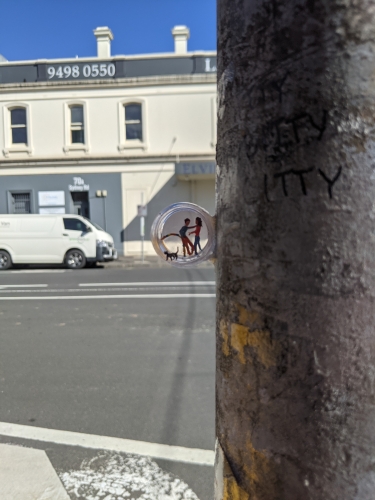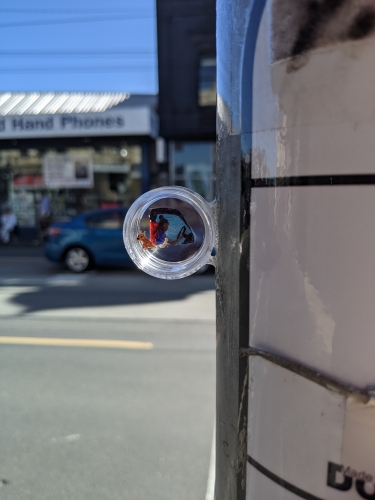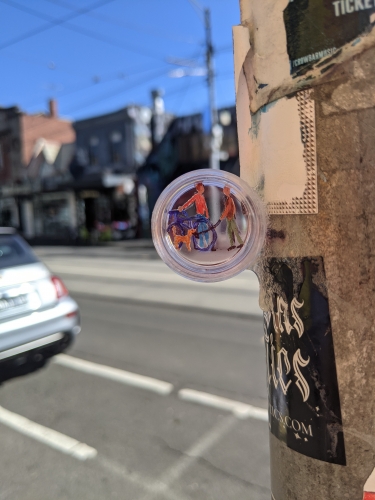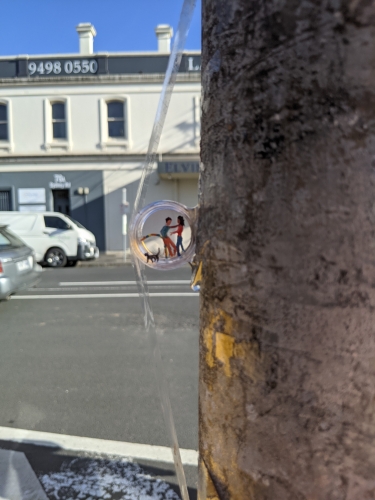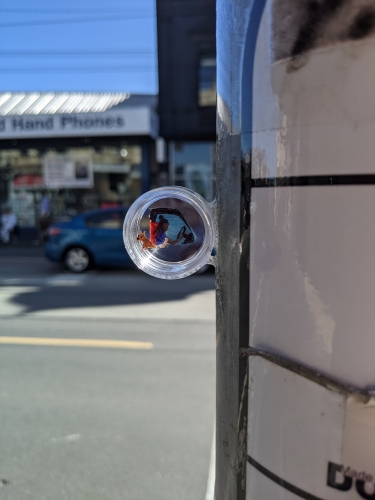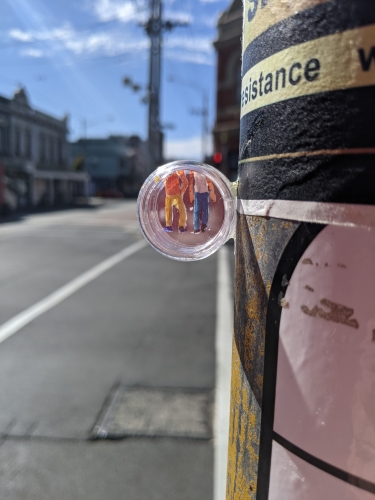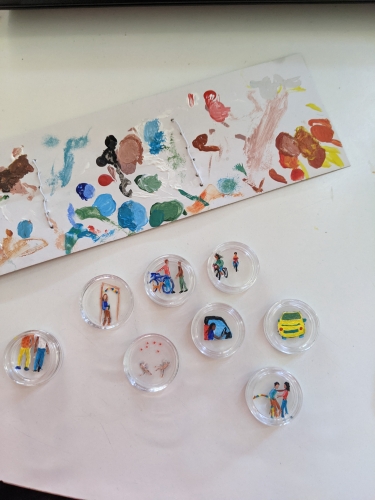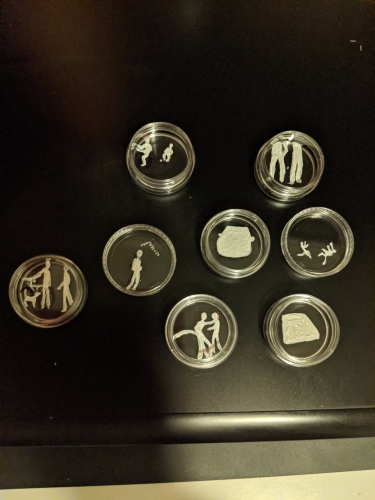
WEEK 4:
THEME: PLACE
CONTEXT:
My first idea was learning how to scan in building shapes with open CV and animating over them, but after 2 days dedicated to open CV tutorials, I knew I wouldn't have enough time. My second idea was creating a series of posters, warning people against an evil race of aliens living among us, with the sub narrative that they are actually innocent and we're demonizing them into hiding, an idea I considered up until I found the resources to act on another idea faster. And my third was to travel to tram stops all around melbourne and make hop-skotches, then use them and encourage strangers to too, while I film, which I'm honestly a little too socially nervous to do by myself but will consider for a future project.
The premise I ended up focusing on was to create tiny scenes peopled with tiny characters, maybe even comedic scenes, then affix them to street poles or fixtures so that people could imagine them taking place across the street from the pole, or on a buildings roof or whatever they could be projected on. I originally envisioned doing this with clay, based on the artist Slinkachu and their micro sculpture series, though I ended up doing it with paint and plastic instead.
Slinkachu creates tiny, often comedic, scenes using model train people figurines and then 'abandons' them around cities to be found and appreciated by people. His works always comment upon the locations they're put in, whether it's re-contextualizing a bag of chips as a cave or a puddle as a lake. Despite the playfulness of his work, which is largely made of toys, in interviews Slinkachu describes his goals as more somber and meditative in nature, giving people a sense of how small human beings really are relative to the rest of the world. The main element I took from his artistic philosophy was a viewer's act of "discovery" upon finding a tiny hidden artwork and being able to place it in their own context and have total power over it for the time they have it. For all I know, someone on the street could interact with, or even destroy my artworks, now that they're installed. In a sense they belong to the public now, as with all street art. They're now a part of my community.
METHOD:
You will need:
A bunch of cheap tiny glitter tubs from the dollar store, acrylic paint, a sharpie, alcohol, tape and glue.
Take your containers, open them and hold 1 half against a pole, bike stand, streetlight etc and quickly sketch out a scene with your sharpie, focusing on a real landmark like a bike rack, car, doorway or pole so the drawing is easy to put back in its intended context.
Paint white figures over the sharpie, let dry, then fill in with coloured paint (maybe use markers next time for more precision). Let dry.
Now close the containers and paint additional decor on outer shell if needed. Use alcohol to thin paint and remove unwanted sharpie.
Affix back to poles with an 'H' of scotch tape so they are positioned correctly, then glue with rubber sealant. Allow to dry for a day and then remove tape.
Photograph.
RESPONSE:
This week I made a series of micro paintings of every day people, talking or commuting, inside tiny transparent circular plastic boxes. The ideal response this would illicit would be a commuter finding one, looking through it and trying to orient their eye as to place it so its perspective and scale matches a distant place, possibly looking of other perspectives in which it makes sense, and then going off to find another one. In frequent trips through Brunswick, they might even discover them all.
I chose to paint people, and not fantastical or unusual scenes, for a few reasons, though in retrospect I may have been thinking too vertically (as in, measuring success by pulling from ideas I've already seen working, instead of taking chances). My first reason is that people are a common understandable object, the scale and complex visual language of which are easily understood by strangers. This is likely similar to some of Slinkachu's reasoning, as with many other graffiti artists who create human expressions and shapes. It also recontextualizes people, specifically their interactions as something simple and beautiful to be appreciated, when you show them so symbolically and in a tiny format, not dissimilar to the effect of tilt-shift photography.
In the end I chose this particular idea because I find that kind of miniaturization charming and something I wanted to bring to my practice. Also because it turned out to be very time and resource effective for someone who had thrown around ideas until late in the week. There were no shortage of tiny transparent boxes available and cheap at every craft store I found. If I were to do this project again, I would buy slightly larger boxes for more detailed painting, in a wide variety of shapes for visual interest. Though I actually really like the spyglass-like effect the small round boxes give me.
Generally I'm looking to engage and entertain people, give them a playful moment within the day, upset the course of mundane city life, and also to invite the viewer to appreciate the simple beauty of strangers talking and living as an artwork. I chose sidewalks and crosswalks in particular because they're a stopping place for distracted, otherwise busy people, an idea group to ask to engage with something strange, hidden and playful. Also having something at eye height to occupy you while you wait for the light to change is entertaining and the brief moment of waiting gives my works just enough time to be discovered and appreciated. There is entertainment value in being the few to discover them, much like Slinkachu's work, but also entertainment value in examining and using them.
I would say, for next time, I would broaden out my idea a little before settling down quite so fast. As I said, as charming as the idea of tiny people projected over big spaces is, I was drawn to it because its been done before successfully, and therefor it doesn't really add much to the field of public graffiti. I think it should have been expanded and played with more. However, just because it doesn't revolutionise some field of art doesn't mean it didn't add something new and strange to my practice.
This week, I acted out play as personal progress, in the sense that I don't usually paint and I've never done an outdoor work before. I commited my works to public scrutiny and action, allowing people to discover, play with and even destroy them. The idea that my works are out of my hands and a part of my community demonstrates play in the sense of building on my community's identity and also communicating with my community. And finally my works express play as frivolity, as an invitation to be imaginative, to discover, to interact and reep minor visual rewards, consequence free and separate from the day to day tasks their commute is tied to.
About This Work
By Holland Kerr
Email Holland Kerr
Published On: 31/03/2021
